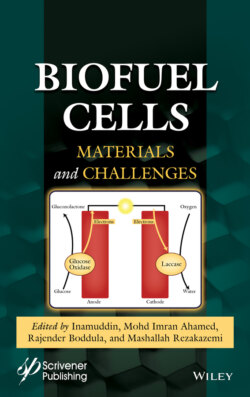Читать книгу Biofuel Cells - Группа авторов - Страница 15
1.2.2 Reactions Catalyzed by Microorganisms
ОглавлениеConventional MFCs utilize abiotic cathodes; however, limitations for the oxygen reduction reaction are present similarly to what is observed in electrochemical cells. The use of biocathodes as an alternative to metallic cathodes was proposed in 2005 [25].
The biocathodes are classified as a function of the terminal electron acceptor available. Aerobic biocathodes utilize oxygen as final acceptor; of electrons electron transfer occurs via the reduction of a mediator such as iron and manganese and then, the mediator is oxidized by the bacteria. Anaerobic biocathodes directly reduce acceptors such as nitrate and sulfate [26].
Suitable bacteria for indirect electron transfer are Leptothix discophora, which is able to reduce MnO2 to manganese ion [27], and Acidithiobacillus ferrooxidans an iron oxidizing bacterium [28], while consortia of electroactive microorganisms for direct transfer can be found in sediment and anaerobic sludge [29, 30]. An exhaustive evaluation of the electroactivity capabilities of diverse bacterial species was reported by Cournet et al. [31].
Hybrid microbial bioelectrochemical systems include MFC fueled by light energy; this is achieved by oxygenic photosynthetic organisms, such as microalgal and cyanobacteria species. Photosynthetic organisms transfer electrons to the anode, or to heterotrophic microorganisms which in turn transfer the charge to the anode.
Energy pathways in cyanobacteria occur in the thylakoid membranes containing respiratory electron transfer chain components and in the cytoplasmic membrane with a respiratory electron transfer short chain. Since the electron transfer is not adapted for extracellular electron transport, mutant strains for electron export ability are being obtained [32]. Synechocystis have three respiratory terminal oxidase complexes for the reduction of oxygen and mutants lacking respiratory terminal oxidases showed increased ferricyanide reduction rate [32]. However, the mechanism for electron excretion to the periplasmatic space and beyond remains unresolved; hypothesis on the presence of nanowires, an assimilatory metal reduction pathway, and endogenous mediators have been stated.
One additional advantage of MFCs over general bioreactors is the possibility to adapt the microbial metabolism of the inoculum as function of the set electrode potential. This procedure enables one to increase the selectivity of the reactions and the galvanic mode of operation can become electrolytic [33].
Table 1.1 Cell potential for typical reactions with microbial bioanode, and a microbial biocathode.
| Microbial bioanode | Cathode | Cell potential |
| CH3COOH + 2H2O → CO2 + 8H+ + 8e− | 2H+ + 2e− → H2 | E = 0.134 V |
| E = −0.280/NHE | E = −0.414 V/NHE | |
| Anode | Microbial biocathode | |
| 2H2O → O2 + 4H+ + 4e- | CO2 + 8 H+ + 8 e− → CH4 + 2H2O | E = 1.064 V |
| E = 0.820 V/NHE | E = −0.244V/NHE |
Microbial electrolysis cells (MECs) operate under a constant electrical supply, therefore this energy represents an operation cost and a decrease in the energy efficiency. To overcome these issues, the use of alternative energy technologies has been proposed [34]. Another alternative to reduce the cost of energy supply is an intermittent operation for conversion of CO2 into organic products using a biocathode [35].
The thermodynamic cell voltage for hydrogen production from acetate oxidation in a bioanode, and methane production in a biocathode from water oxidation is resumed in Table 1.1. At least theoretically, these reactions present advantages compared to totally abiotic processes for gaseous fuel production. For instance, water electrolyzers require 1.23 V for hydrogen formation while the bioelectrolysis of water requires 0.134 V.
